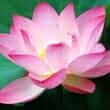Background
- Lotus (Nelumbo nucifera) has been used throughout Egypt, the Middle East, India, and China since ancient times, primarily as a food, but also as a medicine. The flowers, seeds, leaves, fruit, and rhizomes of the lotus are all edible. The petals of the flower are used as a wrap for foods in Asia, and the rhizome is a common ingredient in soups and stir-fries.
- Lotus flowers, leaves, seeds, and fruit have been used traditionally to treat a variety of conditions, including diarrhea, abnormal bleeding, poor digestion, fever, and insomnia. There is not enough scientific research on the use of lotus for treatment of any condition.
References
- Bor JY, Chen HY, Yen GC. Evaluation of antioxidant activity and inhibitory effect on nitric oxide production of some common vegetables. J Agric.Food Chem 3-8-2006;54(5):1680-1686.
View Abstract - Cho EJ, Yokozawa T, Rhyu DY, et al. Study on the inhibitory effects of Korean medicinal plants and their main compounds on the 1,1-diphenyl-2-picrylhydrazyl radical. Phytomedicine. 2003;10(6-7):544-551.
View Abstract - Huang CJ, Wu MC. Differential effects of foods traditionally regarded as 'heating' and 'cooling' on prostaglandin E(2) production by a macrophage cell line. J Biomed.Sci 2002;9(6 Pt 2):596-606.
View Abstract - Jung HA, Kim JE, Chung HY, et al. Antioxidant principles of Nelumbo nucifera stamens. Arch Pharm Res 2003;26(4):279-285.
View Abstract - Kashiwada Y, Aoshima A, Ikeshiro Y, et al. Anti-HIV benzylisoquinoline alkaloids and flavonoids from the leaves of Nelumbo nucifera, and structure-activity correlations with related alkaloids. Bioorg.Med Chem 1-17-2005;13(2):443-448.
View Abstract - Kuo YC, Lin YL, Liu CP, et al. Herpes simplex virus type 1 propagation in HeLa cells interrupted by Nelumbo nucifera. J Biomed.Sci 2005;12(6):1021-1034.
View Abstract - Ling ZQ, Xie BJ, Yang EL. Isolation, characterization, and determination of antioxidative activity of oligomeric procyanidins from the seedpod of Nelumbo nucifera Gaertn. J Agric.Food Chem 4-6-2005;53(7):2441-2445.
View Abstract - Liu CP, Tsai WJ, Lin YL, et al. The extracts from Nelumbo Nucifera suppress cell cycle progression, cytokine genes expression, and cell proliferation in human peripheral blood mononuclear cells. Life Sci. 6-25-2004;75(6):699-716.
View Abstract - Masuda J, Urakawa T, Ozaki Y, et al. Short photoperiod induces dormancy in Lotus (Nelumbo nucifera). Ann Bot (Lond) 2006;97(1):39-45.
View Abstract - Mukherjee PK, Mukherjee D, Maji AK, et al. The sacred lotus (Nelumbo nucifera) - phytochemical and therapeutic profile. J Pharm Pharmacol 2009;61(4):407-22.
View Abstract - Qian JQ. Cardiovascular pharmacological effects of bisbenzylisoquinoline alkaloid derivatives. Acta Pharmacol.Sin. 2002;23(12):1086-1092.
View Abstract - Rai S, Wahile A, Mukherjee K, et al. Antioxidant activity of Nelumbo nucifera (sacred lotus) seeds. J Ethnopharmacol. 4-6-2006;104(3):322-327.
View Abstract - Sohn DH, Kim YC, Oh SH, et al. Hepatoprotective and free radical scavenging effects of Nelumbo nucifera. Phytomedicine. 2003;10(2-3):165-169.
View Abstract - Wu S, Sun C, Cao X, et al. Preparative counter-current chromatography isolation of liensinine and its analogues from embryo of the seed of Nelumbo nucifera GAERTN. using upright coil planet centrifuge with four multilayer coils connected in series. J Chromatogr.A 7-2-2004;1041(1-2):153-162.
View Abstract - Wu, M. J., Wang, L., Weng, C. Y., and Yen, J. H. Antioxidant activity of methanol extract of the lotus leaf (Nelumbo nucifera Gertn.). Am.J.Chin Med. 2003;31(5):687-698.
View Abstract







